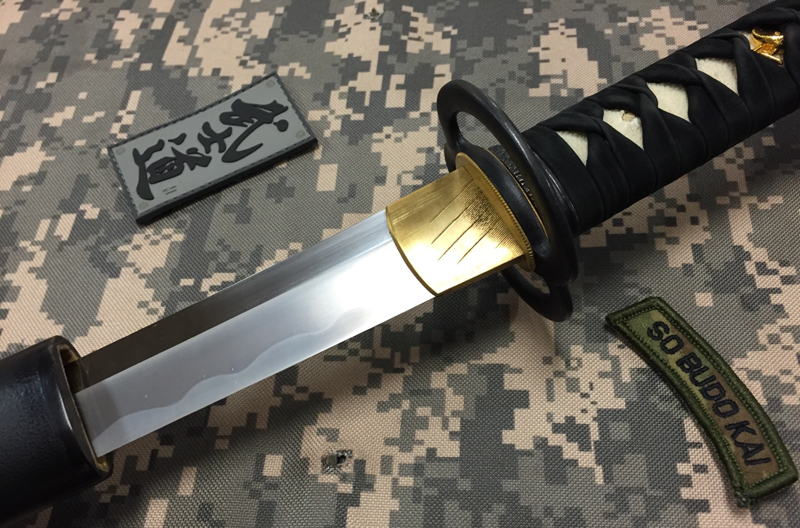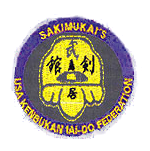Iai-do History
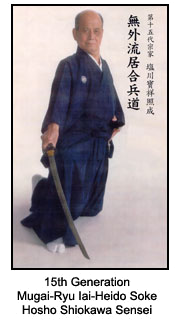 Chivalry in Japan was taught that sword is one's spirit, and spirit with integrity brought forth-honorable use of the sword. With this essence at heart, the samurai warriors sought the dignity in perfecting the sword within, both internally and externally refining their own vitality while striving for perfection.
Chivalry in Japan was taught that sword is one's spirit, and spirit with integrity brought forth-honorable use of the sword. With this essence at heart, the samurai warriors sought the dignity in perfecting the sword within, both internally and externally refining their own vitality while striving for perfection.
The composition of the Japanese sword is made of two different metals; the inner core is soft to sustain possible snap from sudden impact and the outer shell is made of hard steel forged over and over again for it's rigidity and the striking power to cut. For the tempered edge, the blade is covered with special heat resistant clay. It is designed with a curved blade, enabling to draw the sword as fast as possible.
Iai-Do is "deceptively complex" art of drawing Japanese swords commonly known as Katana. Though Iai-Do is a way to cut down an enemy by taking command of the adversary's fate, Iai-Do is not intended to be overpowering or eagerly aggressive because every movement is precisely controlled. While walking, standing, or even when seated, one must always be fully alert and aware of the surroundings, invariably prepared to cut down the enemies in accords with austere etiquette.
HISTORY OF MUGAI RYU
 According to Mugai Ryu "Iai Heido” today it is more commonly referred to as "Iai Hyodo'" published by the 15th Headmaster Soke Hosho Shiokawa in 1986, Tsuji Gettan Sukemochi (1649~1728) 辻月丹資茂 founded the Mugai Ryu style and written the Mugai Shinden Kenpo.
According to Mugai Ryu "Iai Heido” today it is more commonly referred to as "Iai Hyodo'" published by the 15th Headmaster Soke Hosho Shiokawa in 1986, Tsuji Gettan Sukemochi (1649~1728) 辻月丹資茂 founded the Mugai Ryu style and written the Mugai Shinden Kenpo.
Tsuji Gettan Sukemochi, from hereafter just referred to as Gettan, was born in village of Masugi in Omi district (presently Shiga prefecture), and his father served Sasaki Takatsuna. At age of 13, Gettan left home for Kyoto to study Yamaguchi Ryu Kenjutsu from Yamaguchi Bokushinsai. Gettan trained with him for thirteen years and at age of 26, he received “Menkyo Kaiden,” mastery of the Art. Then he left for Edo (presently Tokyo) and opened his own dojo in a town called Kojimachi.
Mugai Enlightenment
During his earlier time in Edo, Gettan realized he needed Zen (Spiritual and Mind training) to further understand his study of swordsmanship. Thus, he studied Zen and classical Chinese Literature from a Zen Master, Monk Sekitan, at Kykoji temple in Azabu town. In 1694, at age of 45, Gettan is said to have reached his Enlightenment, SATORI. In Zen world, an enlightenment usually means that one’s mind and spiritual pursuit reach the absolute clarity and/or certainty.
Gettan solved mystery of his own pursuit, MUGAI, thus written the “Mugai Shinden Kenpo.” The term MUGAI is in the poem below Gettan received from Monk Sekitan while under his zen training. Gettan is believed to have placed tremendous Zen emphasis in his swordsmanship. According to Gettan, “Sword and Zen are of the same Path.” Note: Some researchers protested their new discovery that Mugai Shinden Kenpo is actually a book of zen, not a book focused on the swordsmanship.
一方実無外 - Ippou jitsu mugai
乾坤得一貞 - Kenkon toku ittei
吸毛方納密 - Suimo hou nomitsu
動着則光精 - Douchaku soku kousei
Due mostly to Zen enlightenment implemented deeply in his new sword way, Gettan’s reputation excelled. He not only had many students but numerous influential lords were his students as well. Among them three Major Lords known as Dai Daimyo(s) were: Ogasawara Sadonokami Nagashige · 4th Generation Lord of the Mikawa Yoshida Province, Sakai Tadataka · 5th Generation Lord of the Maebashi Province at the time, but generations later Sakai heirs were transferred to Hemeji Province, and Yamanouchi Toyomasa · 4th Generation Lord of the Tosa Province.
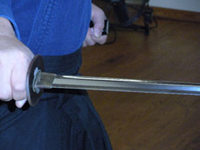 Additionally, 32 lords from medium to smaller sized provinces, Dai or Sho Myo, around 150 Jikisan (upper class Samurai, directly connected or employed by Shogun) and 932 Baishin (lower class Samurai).
Additionally, 32 lords from medium to smaller sized provinces, Dai or Sho Myo, around 150 Jikisan (upper class Samurai, directly connected or employed by Shogun) and 932 Baishin (lower class Samurai).
Gettan was well respected sword master of his time. Though he did not choose a lord to serve, he had many lords as his students. A lord, Daimyo, is like a governor of each state or province and some Dai Daimyo and Daimoyo had significant posts in Bakufu (Shogun’s Central Government). They were extremely powerful and influential.
In addition to the sizes of province the lords ruled, the levels of positions in the Bakufu measured their political strength. If a samurai does not have a lord to serve, then he is regarded as the lowest class of samurai. For a sword instructor such as Gettan, having no lord to serve would normally suggest lower demand to draw new students. Not at first, however, it was different for Gettan. His supreme understanding of Zen and the sword, Gettan placed a deep impact in the history of the Japanese sword schools.
Mugai Ryu Lineage
Gettan did not have a son, so years later he sent his nephew Tsuji Uheita to Lord Sakai Tadataka’s Maebashi Province (later Himeji Province) as the Shinanyaku (Clan’s Head swordmaster), and also sent his adopted son, Tsuji Sukehide to lord Yamanouchi Toyomasa’s Tosa Province as the Shinayaku. This is the beginning of the two Mugai Ryu Lineage.
• Founder of the art - Tsuji Gettan
• 2nd Headmaster - Tsuji Uheita
• 3rd Headmaster - Tsuji Sukehide
Gettan also learned Jikyo Ryu Iai from its founder Taga Jikyoken Morimasa and then implemented into his Mugai Ryu curriculum. Taga Jikyoken Morimasa learned Shin-Tamiya Ryu Iai from Wada Heisuke Masakatsu, and this lineage goes all the way to the Tamiya Ryu, the founder Tamiya Heibei Narimasu. His teacher was Hayashizaki Jinsuke Shigenobu, who is widely accepted as the father of Iai.
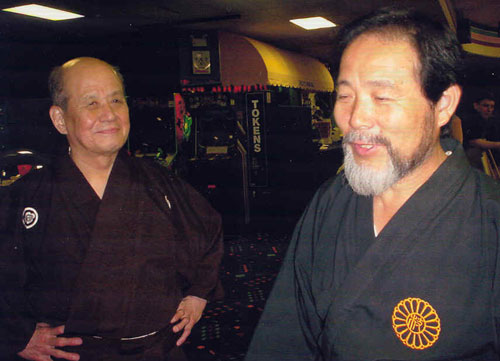
Soke Hosho Shiokawa & Hanshi M. Sakimukai (2002)
Nakagawa Mugai Ryu Iai Heido, or Iaihyodo
The next few Tsuji heirs, as well as those who ranked high in the Mugai Ryu dojo(s) continued to learn Jikyo Ryu Iai from its succeeding headmasters until this style met its fate, marking the Sixth headmaster their last. Though the lineage of Jikyo Ryu Iai was lost, its name and the kata were kept in the Mugai Ryu curriculum for centuries. As a result, the Mugai Ryu masters taught Jikyo Ryu Iai.
Soke Nakagawa Shiryu Shinichi practiced both Himeji and Tosa lines of Mugai Ryu Iaido and later combined the two, hence created the new line and named it, Mugai Ryu "Iai Heido" or "Iai Hyodo."
MUGAI RYU IAIHEIDO LINEAGE
• 13th Headmaster: Soke Shiryu Nakagawa
• 14th Headmaster: Soke Ishii Gogetsu
• 15th Headmaster: Soke Hosho Shiokawa
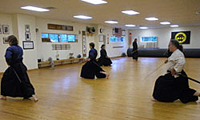 Soke Hosho Shiokawa was a senior Jodo student to Soke Masaharu Sakimukai under Shihan Asakichi Nakajima. Soke Hosho Shiokawa was first announced as the 14th Headmaster of Mugai Ryu Iaiheido then later Soke Shiokawa corrected himself to 15th Headmaster.
Soke Hosho Shiokawa was a senior Jodo student to Soke Masaharu Sakimukai under Shihan Asakichi Nakajima. Soke Hosho Shiokawa was first announced as the 14th Headmaster of Mugai Ryu Iaiheido then later Soke Shiokawa corrected himself to 15th Headmaster.
Kenbukan Iaido was established within the Chintokan Karate - Do dojo, Wilmington, Delaware in 1984, and So Shihan Sakimukai was the first and only student at the time. Then, Kenbukan Iaido Honbu was relocated to Jacksonville, FL in 1991. Hanshi M. Sakimukai received the Mugai Ryu Iaiheido Menkyo Kaiden in 1996, and soon after 10th Dan and Hanshi Shogo in Iaido from Soke Hosho Shiokawa. Hanshi M. Sakimukai also received Muso Shinden Ryu Iaido training from late Hanshi Isao Tomioka from Kagoshima Zen Nippon Kendo Renmei.
